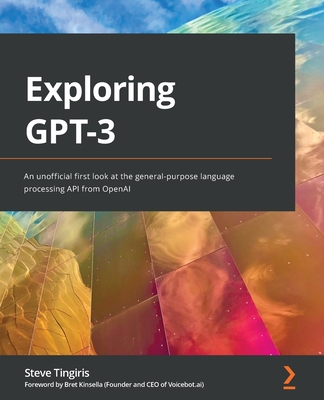OpenAI GPT For Python Developers - 2nd Edition: The art and science of building AI-powered apps with GPT-4, Whisper, Weaviate, and beyond
El Amri, Aymen
買這商品的人也買了...
-
 電腦網路, 5/e (Computer Networks, 5/e) (授權經銷版)
電腦網路, 5/e (Computer Networks, 5/e) (授權經銷版)$940$893 -
 A Visual Guide to Stata Graphics, 3/e (Paperback)
A Visual Guide to Stata Graphics, 3/e (Paperback)$3,780$3,591 -
 Deep Learning 深度學習基礎|設計下一代人工智慧演算法 (Fundamentals of Deep Learning: Designing Next-Generation Machine Intelligence Algorithms)
Deep Learning 深度學習基礎|設計下一代人工智慧演算法 (Fundamentals of Deep Learning: Designing Next-Generation Machine Intelligence Algorithms)$620$490 -
 學會 TensorFlow 之後呢?最尖端的 21個夢幻範例實作
學會 TensorFlow 之後呢?最尖端的 21個夢幻範例實作$680$578 -
 初探深度學習|使用 TensorFlow (TensorFlow for Deep Learning: From Linear Regression to Reinforcement Learning)
初探深度學習|使用 TensorFlow (TensorFlow for Deep Learning: From Linear Regression to Reinforcement Learning)$480$379
相關主題
商品描述
The knowledge you'll acquire from this guide will be applicable to the current families of GPT models (GPT-3, GPT-3.5, GPT-4, etc.) and will likely also be relevant to GPT-5, should it ever be released.
OpenAI provides APIs (Application Programming Interfaces) to access their AI. The goal of an API is to abstract the underlying models by creating a universal interface for all versions, allowing users to use GPT regardless of its version. This guide aims to provide a comprehensive, step-by-step tutorial on how to utilize GPT-3.5 and GPT-4 in your projects via this API. It also covers other models, such as Whisper and Text-to-Speech. If you're developing a chatbot, an AI assistant, or a web application that utilizes AI-generated data, this guide will assist you in achieving your objectives. If you have a basic understanding of the Python programming language and are willing to learn a few additional techniques, such as using Pandas Dataframes and some NLP methods, you possess all the necessary tools to start building intelligent systems with OpenAI tools. Rest assured, you don't need to be a data scientist, machine learning engineer, or AI expert to comprehend and implement the concepts, techniques, and tutorials presented in this guide. The explanations provided are straightforward and easy to understand, featuring simple Python code, examples, and hands-on exercises. This guide emphasizes practical, hands-on learning and is designed to assist readers in building real-world applications. It is example-driven and provides numerous practical examples to help readers understand the concepts and apply them to real-life scenarios to solve real-world problems. By the end of your learning journey, you will have developed applications such as:- Fine-tuned, domain-specific chatbots.
- An intelligent conversational system with memory and context.
- A semantic modern search engine using RAG and other techniques.
- An intelligent coffee recommendation system based on your taste.
- A chatbot assistant to assist with Linux commands
- A fine-tuned news category prediction system.
- An AI-to-AI autonomous discussion system to simulate human-like conversations or solve problems
- An AI-based mental health coach trained on a large dataset of mental health conversations
- and more!
By reading this guide and following the examples, you will be able to:
- Understand the different models available, and how and when to use each one.
- Generate human-like text for various purposes, such as answering questions, creating content, and other creative uses.
- Control the creativity of GPT models and adopt the best practices to generate high-quality text.
- Transform and edit the text to perform translation, formatting, and other useful tasks.
- Optimize the performance of GPT models using various parameters and options such as max_tokens, temperature, top_p, n, stream, logprobs, stop, presence_penalty, frequency_penalty, best_of, and others.
- Stem, lemmatize and reduce your costs when using the API.
- Understand Context Stuffing, chaining, and practice prompt engineering.
- Implement a chatbot with memory and context.
- Create prediction algorithms and zero-shot techniques and evaluate their accuracy.
- Understand, practice, and improve few-shot learning.
- Understand fine-tuning and leverage its power to create your own fine-tuned models.
- Understand and use fine-tuning best practices
- Practice training and classification techniques using GPT.
- Understand embedding and how companies such as Tesla and Notion are using it.
- Understand and implement semantic search, RAG, and other advanced tools and concepts.
- Integrate a Vector Database (e.g.: Weaviate) with your intelligent systems.
商品描述(中文翻譯)
這本指南所提供的知識適用於目前的GPT模型家族(如GPT-3、GPT-3.5、GPT-4等),並且對於未來可能發布的GPT-5也可能具有相關性。OpenAI提供API(應用程式介面)來存取他們的人工智慧。API的目標是通過創建一個通用介面,將底層模型抽象化,使用戶可以使用GPT,而不受其版本的限制。本指南旨在通過API在您的項目中全面、逐步地介紹如何利用GPT-3.5和GPT-4。它還涵蓋了其他模型,如Whisper和Text-to-Speech。如果您正在開發聊天機器人、人工智慧助手或利用人工智慧生成的數據的網絡應用程序,本指南將幫助您實現目標。如果您對Python編程語言有基本的了解並願意學習一些額外的技巧,例如使用Pandas Dataframes和一些自然語言處理方法,您就具備了使用OpenAI工具開始構建智能系統所需的所有必要工具。請放心,您不需要成為數據科學家、機器學習工程師或人工智慧專家,就能理解和實施本指南中介紹的概念、技術和教程。所提供的解釋直接明了,並且具有簡單的Python代碼、示例和實踐練習。本指南強調實踐性、實踐學習,旨在幫助讀者構建真實世界應用程序。它以實例為驅動,提供了許多實際示例,幫助讀者理解概念並將其應用於解決真實世界問題的實際情境。在學習過程結束時,您將開發出以下應用程序:- 經過微調的特定領域聊天機器人。- 具有記憶和上下文的智能對話系統。- 使用RAG和其他技術的語義現代搜索引擎。- 基於您的口味的智能咖啡推薦系統。- 協助Linux命令的聊天機器人助手。- 經過微調的新聞類別預測系統。- 基於AI的AI自主討論系統,模擬人類對話或解決問題。- 基於大量心理健康對話數據集訓練的基於AI的心理健康教練。- 等等!通過閱讀本指南並按照示例操作,您將能夠:- 了解不同的可用模型,以及如何在何時使用每個模型。- 為各種目的生成類似人類的文本,例如回答問題、創建內容和其他創意用途。- 控制GPT模型的創造力,並採用最佳實踐生成高質量的文本。- 轉換和編輯文本以執行翻譯、格式化和其他有用的任務。- 使用各種參數和選項(如max_tokens、temperature、top_p、n、stream、logprobs、stop、presence_penalty、frequency_penalty、best_of等)優化GPT模型的性能。- 在使用API時進行詞幹提取、詞形還原和成本降低。- 了解上下文填充、鏈接和實踐提示工程。- 實現具有記憶和上下文的聊天機器人。- 創建預測算法和零樣本技術,並評估其準確性。- 了解、實踐和改進少樣本學習。- 了解微調並利用其能力創建自己的微調模型。- 了解並使用微調的最佳實踐。- 使用GPT進行培訓和分類技術。- 了解嵌入和特斯拉、Notion等公司如何使用它。- 了解並實施語義搜索、RAG和其他高級工具和概念。- 將向量數據庫(例如:Weaviate)與您的智能系統集成。
























